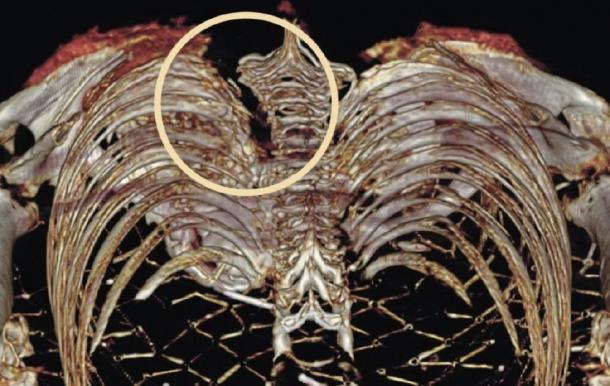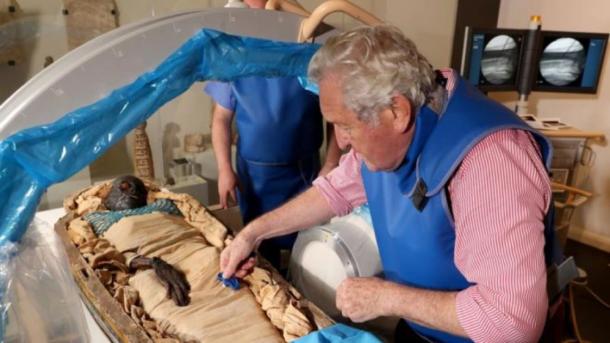Researchers have established that Northern Ireland’s most famous Egyptian mummy was murdered. The mummy, which is the cadaver of a woman called Takabuti who lived 2,600 years ago, is now known to have been stabbed in the back with an axe. A team of experts has also made a number of other discoveries about the woman, which is providing new insights into ancient Egypt during the 25th Dynasty.
Takabuti is believed to have lived in Thebes, near modern Luxor. It appears that she was either the wife or the mistress of a noble. She was a daughter of an Egyptian priest and died in her twenties. During the 19th century, “her mummy got caught up in the mummy trade that followed the Napoleonic Wars,” according to Live Science . It was purchased in Egypt by Thomas Greg, a wealthy merchant, who brought the cadaver back with him to Belfast, in 1834.
First Egyptian Mummy in Ireland
The mummy was the first one known to be brought to Ireland and her arrival caused a sensation. It was unwrapped in Belfast in 1835, and the hieroglyphs on the painted coffin were deciphered by Sir Thomas Hincks. Dr. Greer Ramsey, a Curator of Archaeology at the National Museums (NI), told The University of Manchester that “there is a rich history of testing Takabuti since she was first unwrapped in Belfast in 1835.” Earlier studies have shown that Takabuti was a petite young woman with styled auburn hair, who did not shave her head, which was the custom.

The ancient burial case of Ireland’s Egyptian mummy Takabuti. ( Ulster Museum, Belfast )
However new technologies have allowed researchers to investigate the mummy in a new and unprecedented way. A multidisciplinary team of experts from academic institutions and museums in Northern Ireland and England and Kingsbridge Private Hospital (London) used cat-scans, carbon-dating, and DNA analysis in their investigations. A portable CT scanner was used to examine the mummy, and what was found was stunning.
Ireland’s Egyptian Mummy Murdered in Cold Blood
Live Science quotes Dr. Robert Loynes, a retired surgeon as stating that “Takabuti sustained a severe wound to the back of her upper left chest wall.” Based on the injuries it appears that she was stabbed in the back, near her shoulder and “this was almost certainly the cause of her rapid death.” Dr. Eileen Murphy, an archaeologist with Belfast’s Queen’s University, told Live Science that “she died at the hands of another.” The CT scan found some atypical features of her embalming and this may be related to the violent nature of her death.

X-ray showing stab wound of Ireland’s Egyptian mummy Takabuti. (R.D. Loynes / The University of Manchester )
Last year it was believed that Takabuti died from being stabbed with a knife, but a re-analysis of her remains indicates that her assailant likely killed her with an axe instead. The new research also suggests that the weapon was a common axe for both Egyptian and Assyrian solders. This means that “She may have fallen victim to one of her own people,” according to the researchers. They said that her death was probably instant.
The team also identified that the embalmed cadaver of the young woman still contained her heart. This was because the heart was important in Egyptian religion with regard to the deceased’s journey to the afterlife, as it was linked to the individual’s salvation. Previously the heart was believed to have been removed. The organ was found to be intact and was in good condition.
Surprising DNA results
A sample of Takabuti’s DNA was also taken by team members and analyzed. It was established that her DNA was more similar to modern Europeans than the modern population of Egypt. Her genetic footprint is quite rare and almost unknown among ancient or modern Egyptians.
Egyptologist Rosalie David told The University of Manchester that “the surprising and important discovery of her European heritage throws some fascinating light on a significant turning-point in Egypt’s history.” These findings are adding to the body of research that indicates that the ancient Egyptian population was closer genetically to contemporary Europeans than Arabs.

Researchers taking samples for tests from Ireland’s Egyptian mummy Takabuti. ( Ulster Museum, Belfast )
Further analysis of the mummified body also revealed more extraordinary information about the woman who was murdered some 2,600 years ago. It was found that she had 33 teeth and not 32 and that she had an extra vertebra. These are very rare features and only occur in a small percentage of the population.
Bringing Takabuti Back to Life
The research using cutting edge technologies is helping bring Takabuti back to life after over two millennia. Moreover, they are offering new insights into the life of an elite Egyptian woman. Why the young woman was murdered will probably never be known, nor the identity of her killer. But the researchers have published a book on Takabuti’s life and the times she lived in. It’s called ‘ The Life and times of Takabuti in ancient Egypt: investigating the Belfast mummy .’
Top image: Ireland’s Egyptian mummy remains of Takabuti, a woman who was murdered 2,600 years ago in ancient Egypt. Source: Ulster Museum, Belfast
By Ed Whelan
Updated on April 2, 2021.
Related posts:
Views: 0
 RSS Feed
RSS Feed















 April 3rd, 2021
April 3rd, 2021  Awake Goy
Awake Goy  Posted in
Posted in  Tags:
Tags: 
















